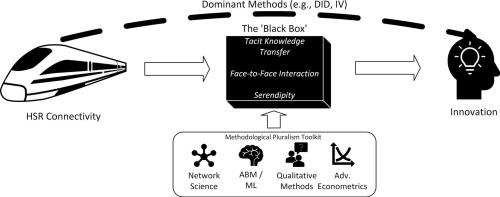高铁与区域创新:衡量得如何?
IF 3.8
Q2 TRANSPORTATION
Transportation Research Interdisciplinary Perspectives
Pub Date : 2025-09-25
DOI:10.1016/j.trip.2025.101647
引用次数: 0
摘要
建立高速铁路(HSR)与区域创新之间的因果关系,并把握这种关系的复杂性,在方法论上提出了重大挑战。虽然高铁理论上可以通过增强连通性来促进创新,但要证明这种联系强有力,需要解决一些问题,如非随机网络布局、空间溢出、网络效应,以及对高铁风险和创新成果的适当衡量。本研究系统地回顾了最近的文献,批判性地评估了这种关系是如何测量的。根据系统评价和荟萃分析的首选报告项目(PRISMA)指南,本系统文献综述综合了35项关键研究(32项实证研究,3篇概念/综述论文)的最终分析方法见解。结果显示准实验方法的明显演变,特别是差异中的差异及其空间变异通常与工具变量相结合以解决内生性问题。然而,重大挑战仍然存在:建立因果效度(平行趋势,工具效度),充分测量高铁暴露于简单连通性之外,捕获异质效应,模拟复杂的空间动态(浓度,衰减),以及经验验证中间机制,如隐性知识转移,这通常仍然是理论上的“黑箱”。此外,大多数方法探索都是在中国高铁的背景下进行的,这引起了对外部效度的担忧。我们的结论是,虽然方法的复杂性正在增加,但目前的方法难以完全捕捉系统复杂性并提供无争议的因果证据。未来的进展需要方法论多元化(使用多种方法),将先进的计量经济学与基于主体的建模、网络科学、机器学习和定性方法等工具结合起来,同时提供更丰富的数据和中国以外的比较研究,为政策提供更有力、更细致的见解。本文章由计算机程序翻译,如有差异,请以英文原文为准。

High-speed rail and regional innovation: How well is it measured?
Establishing a causal link between high-speed rail (HSR) and regional innovation, and capturing the relationship’s complexity, presents significant methodological challenges. While HSR is theorised to boost innovation via enhanced connectivity, proving this link robustly requires navigating issues like non-random network placement, spatial spillovers, network effects, and appropriate measurement of both HSR exposure and innovation outcomes. This study systematically reviews recent literature to critically evaluate how this relationship is measured. Following Preferred Reporting Items for Systematic Reviews and Meta-Analyses (PRISMA) guidelines, this systematic literature review synthesises methodological insights from a final analysis set of 35 key studies (32 empirical, 3 conceptual/review papers). Results show a clear evolution towards quasi-experimental methods, particularly difference-in-differences and its spatial variants often combined with instrumental variables to address endogeneity. However, significant challenges remain: establishing causal validity (parallel trends, instrument validity), adequately measuring HSR exposure beyond simple connectivity, capturing heterogeneous effects, modelling complex spatial dynamics (concentration, decay), and empirically validating intermediate mechanisms like tacit knowledge transfer, which often remain a theoretical 'black box'. In addition, most methodological explorations were conducted in the context of Chinese HSR, raising concerns about external validity. We conclude that while methodological sophistication is increasing, current approaches struggle to fully capture the systemic complexity and provide uncontroversial causal evidence. Future progress requires methodological pluralism (use of multiple methods), integrating advanced econometrics with tools like agent-based modelling, network science, machine learning, and qualitative methods, alongside richer data and comparative research beyond China, to provide more robust and nuanced insights for policy.
求助全文
通过发布文献求助,成功后即可免费获取论文全文。
去求助
来源期刊

Transportation Research Interdisciplinary Perspectives
Engineering-Automotive Engineering
CiteScore
12.90
自引率
0.00%
发文量
185
审稿时长
22 weeks
 求助内容:
求助内容: 应助结果提醒方式:
应助结果提醒方式:


